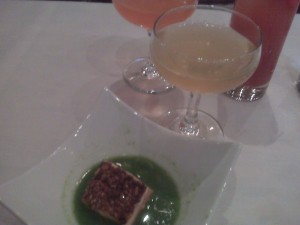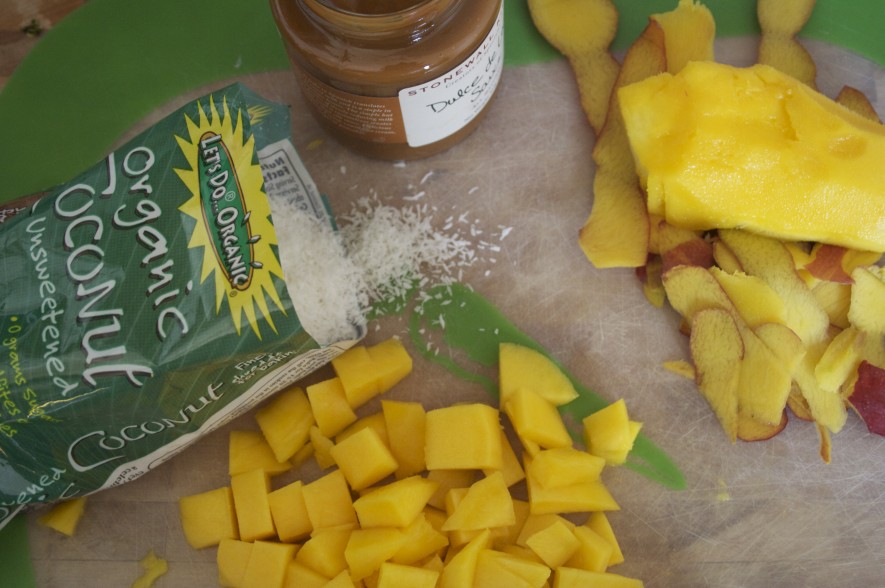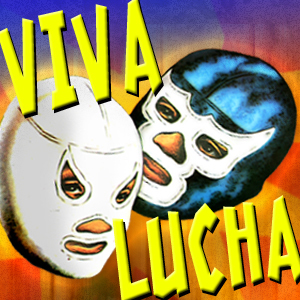Author Archives: Karina
Sara’s Oatmeal
When it comes to oatmeal, I’m all peace and love. I welcome all kinds of oats into my pantry, I don’t discriminate. Sometimes it’s steel cut oats that grace my breakfast table with their texture and nuttiness, leaving their chewy remnants on my copper pot; other times instant is best (especially on dark mornings when my cool sheets hold me captive and I end up rushing out the door in a frenzy). One thing is for sure, though, when it comes to oatmeal, simple is best (none of that peaches and cream, maple and brown sugar stuff). Using plain oats lets me dress up my bowl in a different “outfit” every day. Because my oatmeal, like me, thrives on variety, one day it’ll be a conservative affair, with cinnamon, dollops of honey and a few scattered raisins; and another it’ll be a wild child, spiked with mango, coconut flakes, granola and drizzled with dulce de leche.
Whether you’re an oatmeal virgin or oatmeal pro, here’s a latin-ized interpretation to put a smile on your face and keep you going straight into Spring.
Sara’s Oatmeal
makes 2 servings
1 cup of oats (preferably quick cook)
2 cups of liquid (milk, water or a mixture of both)
cinnamon
1 banana
1 mango
coconut flakes
granola
dulce de leche
Heat liquid and oats in pot to a boil. Meanwhile, slice half of the banana into very thin slivers (this will give your oats a creamy consistency, I picked up this technique at a favorite blog I follow here), and add to pot once it starts to boil. Now, stir mixture briskly with a wooden spoon, until all of the fruit has dissolved into the oats. If you like your oatmeal thicker, cook a few more minutes or remove from heat now. Add your toppings.
Bottled Jewels
Did you know that there are soft drinks produced all over Latin America, and that you can get a taste of a country’s local flavor just by flipping open one of these bottles? In the Dominican Republic, for example, two of the most popular drinks are Merengue and Refresco Rojo, and are available at Dominican restaurants and bodegas around NYC. In Peru, the local palate lusts for Inca Cola, Cola Real and Chicha Morada. I know, I know, when the temperature starts to drop, it’s more fitting to talk about chocolate caliente and atole? But even though the city seems to have changed from green to fall yellow overnight, my memories of summer are still alive.
I was walking to work one day when I stepped into my corner deli to pick up a bottle of water and some flowers for the week. As I paced through the store browsing the cold drinks stocking the fridge something surprised me. An entire shelf was stocked with a line of the quintessential Mexican soft drink Jarritos. Captivated by the bejeweled bottles, I stared at the luminous rainbow of flavors: tamarind, pineapple, jamaica, mandarin, grapefruit, lime.
Not long ago, lime soda became my summer drink of choice. Along with boogie boarding Saturdays. G and I would wake up, pack PBJ’s and rush out of the house to squeeze every moment of our long warm days, returning time and time again to our favorite spot on the Jersey Shore. After an invigorating day of playing with the waves, we would drive home when the last hint of light covered the sky, picking up burritos at our favorite tex-mex joint in Hell’s Kitchen. With salt on my skin and leftover sand between my toes, I would order a bottle of the lime green, psychedelic-looking soda, straight out of the pages of Dr. Seuss.
Latin flavors dominate the scene
The Culinary Institute of America held a seminar about Latin American food called “Latin Flavors, American Kitchens” in its San Antonio campus, with guest chefs including Rick Bayless and Maricel Presilla, two established chefs and ambassadors to Latin American cuisine in the U.S. More and more, Latin American food appears to be influencing restaurant menus throughout the country. Check out the latest newcomer to the Nuevo-Latino food scene in NYC, Nuela. Also, eaters are moving away from fine dining to more casual establishments, which has given opportunities for more Latin American restaurants to break through the market. That is some excellent news, can’t wait to see what the next knock out will be!
Read more about what happened at CIA here.
an ode to color
I promised many things this summer: paletas, cookbook reviews, culinary finds in the city, and even though I haven’t written about them, it doesn’t mean they haven’t been on my mind. The past three months proved to be exhilarating and exhausting. I worked on my thesis for graduate school, which, by the way, ended up being a story about a Dominican restaurant in my neighborhood. It’s called Lali and they serve a mean rice and beans and chicken stew, just like back home. They also have awesome empanadas, tropical juices like chinola and morir soñando, and funny characters (like a sword-swallowing belly-dancer, a Hawaiian performing artist, “Grandpa”). The owners, Lali and Les, were very gracious with letting me hang out in the restaurant all the time, talking to their customers, eating there, taking photos. They made me feel at home.
Now that my project is finished, I miss those hectic days that wouldn’t end until midnight. I would get home full of stories to share, inspired by the strong people that inhabit this city. More than ever, I feel humbled and proud to make NYC home. It’s a generous city that continues to amaze me every single day.
So friends, in honor of home and to kick start the new season (hopefully it will be an especially fruitful one), here are some images capturing the last days of summer.
Woken up by María Sangrienta (aka Bloody Mary)
What better way to welcome a hot summer Sunday than with a Latin-style brunch? With the Gourmet Latino Festival kicking off June 4th at the Astor Center in Manhattan, I was able to savor some of the flavorful innovations that are happening in Latin American cuisine right now throughout the city. Led by chef Aaron

Salmon With Papalo Coconut Broth and colorful Latino-inspired cocktails
Sanchez and other popular names in the world of mixology, I picked up some ideas in the Mexican kitchen (ei. use an onion studded with cloves when you make home-made chicken stock ) and witnessed the creation of original cocktails inspired from traditional Latin ingredients.
The session I attended was a “Levanta Muertos” brunch seminar, a phrase ubiquitous in Latin America, that alludes to a dish or a drink that’s supposed to “wake you up from the dead” and help with your hangover. As the first year of the festival, the turnout of people was impressive. There was not a single seat available at the long tables set up for the diners throughout the space. The event was well organized, although the setup of the space was a bit funky: I was limited to seeing the mixologists in action, but couldn’t really see the chef at work.
After a cheesy introduction that had the two hosts (Sanchez and Olson) playing a pair of drunkards at a bar, the event thankfully picked up. The first creation was a Maria Sangriente, or a Mexican version of the Bloody Mary. This drink was prepared by mixologist Steve Olson and had Mezcal, Tequila, hot chiles, tabasco sauce, salt and pepper as its principal ingredients. The drink was beautifully served in a tall glass with a half chile. It was a feast for the eyes and the palate. After my first swig, its lingering heat and balanced flavors made even a spice-adversed palate like my own second-guess itself. One thing Olson repeated throughout the class was that the key to making a levanta muertos successful is that you should use the same liquor you drank the night before. This he kept referring to as using the “hair of the dog” of the dog that bit you! Kind of weird, but probably true. To nibble on, the chef prepared a huitlacoche tamal with a saffron corn sauce. The tamal took the color of the huitlacoche ( it’s corn fungus), so its masa was a dark almost black color, but tasted heavenly, with a fluffy texture and sauce that was smokey and complex.
The courses that followed all had the colors, textures and heat of traditional Mexican cooking but with a refined twist. There was a Pepita Crusted Salmon in a Papalo Coconut Broth, which was paired with a drink from Phil Ward from Mayahuel restaurant in Manhattan. The drink echoed the colors of the dish as a clear peach elixir, prepared by mixing mezcal, Aperol, Maraschino and lime. The final tasting course was a Stuffed Sweet Plantain with Smoked Black Beans, Epazote and Crema Fresca. This was accompanied by a drink called the Marajoara Magic, by Danny Valdez, the most charismatic of the guests, who prepared a drink with Brazilian cachaca, Carpano Antina, Habanero peppers and Lime oil.
The session was educational and fun, but most of all, I walked out feeling not only impressed at how Latin American flavors can be, but most of all, very proud.
(I took the photos with my phone, the colors were vibrant in real life)
The Return
Hello! I am back my friends, Latinfoodie is back. I know, I know, I have been away for a while, but I’m happy to admit I’ve made some pretty cool discoveries during the past few months. I took a trip to some remote corners of the Baltics (Belgrade), found a Berlin band I love that epitomizes nerdy-cool (The Whitest Boy Alive) and have a new-found obsession with oysters.
Which reminds me how much I love the taste of food by the ocean. When I was a little kid, I would spend summers sitting with my Dad on the hot sand, starving from hours of diving and swimming with my cousins in the warm waters of the tropical sea. We would pull oysters out of a large bucket, slice them open, squirt them with lime and slurp them down under the blazing Dominican sun.
But back to reality. After months of darkness, NYC is alive and back in full Summer swing. Sundresses and flip flops abound, and people are giddy with the heat. I guess we really are creatures of nature: nothing like a little sunshine and warm breeze to make us all feel a bit more relaxed and ready for surprises of the city during this exhilarating time of the year.
I’ve stumbled across some local discoveries that I can’t wait to share with you: from Mexican paletas to smoothies infused with latin flavors, it’s all coming to you this season.
keep your life delicious,
Latinfoodie
Alexia’s Pastelón
 This is the moment you’ve been waiting for.
This is the moment you’ve been waiting for.
Throughout the past 5 days, I’ve gotten many requests for this recipe. Although we are now in the December holiday territory, I urge you to make this sweet potato casserole, or pastelón in Dominican. I got the recipe from my cousin Alexia whom I love with all my heart.(gracias alexia!) Now, it is in your hands my friends. All I can say is that once you make this, prepare to be loved, your holidays will never be quite the same again.
Alexia’s Thanksgiving Pastelón
3 cups mashed sweet potatoes
1 cup sugar
½ cup butter
2 eggs
1 teaspoon vanilla*
½ can of evaporated milk
Ground cinnamon*
Pancake syrup*
Peal the sweet potatoes, cut in quarters and boil in salted water for approx 30 minutes or until soft. Drain and mash slowly with a fork. Add the butter, sugar, evaporated milk, vanilla, cinnamon, maple syrup and the egg yolks.
Beat the egg whites and fold in the mixture. Place in baking dish.
Cover with the topping below.
Topping:
½ cup brown sugar
¼ cup all purpose flour
2 1/2 teaspoons butter (hard)
½ cup chopped walnuts
Ground cinnamon
Bake at 350F for approx. 30 minutes.
* Means: “al ojo” or approximate measurements
Marshmallow woman
When you think of Thanksgiving, what is the first thing that comes to mind? For me it’s a can of jellied cranberry, which I thought was the best cranberry sauce in the world. It is when I moved to the northeastern U.S. that I suddenly started thinking twice about it, and eventually got more snobby with my cranberry sauce, choosing more natural interpretations that could be traced back to the actual fruit. What I finally realized was that what I had been serving with turkey all those years, was a far cry from the deep burgundy sauce prepared in kitchens all over the country with sugar, water, spices and of course cranberries.
In the Dominican Republic, unless you’re somehow linked to the U.S.(have family here, have studied here, have an American spouse, etc), Thanksgiving is not a popular holiday. In my home though, the celebration was welcome every year. Mom instituted the tradition after celebrating it herself with her own family. Although the stories were always nebulous, I gathered that her father, my grandfather, had lived in Puerto Rico and had himself adopted the tradition.
Decades later, my kitchen in Santo Domingo buzzed whenever Turkey day would come along. My aunt Tiita took over one of the counters, mixing her secret “Russian” potato salad adding a little of this and a little of that until it was just perfect. Mom pulled out the glistening golden turkey for one last baste. Plantain pasteles filled with shredded chicken boiled in a huge pot. Piping hot rice with kidney beans (moro) was scooped into a huge bowl, sweet potato casserole with marshmallows toasted in the oven.
The table was set. The feast was underway. I had the task of slicing the cranberry “sauce”. I loved the feel of my knife going through the shiny jelly shaped like its can. I loved how each ring was equal to the next and I took pride in lining them up, each one resting on the next. Then families and friends who had gathered on the terrace enjoying the (hopefully) cooler breezes of November and laughing and drinking would gather round the table. My Mom would give thanks, her spirit as bright as her blond bob. We would dig into the spread of American and Dominican dishes, and forget that these moments existed only for that day.
In our minds, they would always come again, they would last forever.





Food For Thought